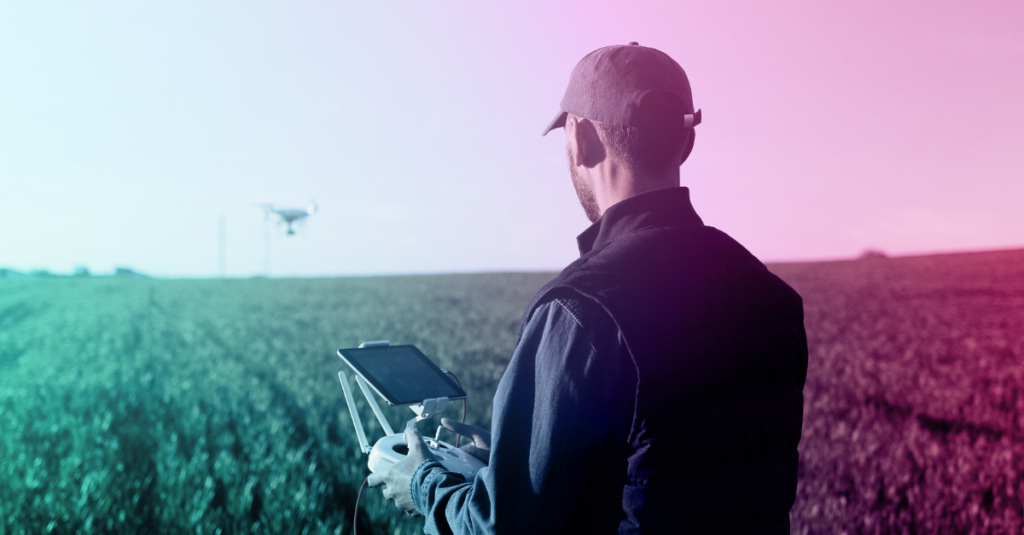From autonomous tractors and smart irrigation systems to drones and supply chain tracking, connected technologies are transforming the way we feed the world. With agriculture currently generating up to 28% of total greenhouse gas (GHG) emissions, the pressure is on to develop a more sustainable food system, make the best possible use of resources and reduce waste.
Research indicates that, if a quarter of farms worldwide adopted precision agriculture, using artificial intelligence (AI), connected technologies and data analysis software, they could save water, reduce emissions and save up US$100 billion in annual expenditure by 2030.
How do we get there? Here are just some ways connected technologies and agritech can help improve food security, mitigate the effects of climate change and help reduce agriculture’s carbon footprint.
Water management and control
70% of the world’s fresh water is used for agriculture. As much as 40% of that water is lost to poor irrigation systems, evaporation and overall inefficient water management.
Agritech, AI and smart irrigation systems can help farmers and other food producers to be more resilient in the face of environmental risk, while maximising every last drop used. For example, connected sensors controlling plant or soil moisture can help improve the quality of sensitive crops such as wine grapes or other high-water consuming foods like almonds (which consume up to 5l of water per nut). Some smart irrigation providers claim that they can save 50% of water and increase crop yield by 30% using wirelessly controlled precision irrigation for pre-configured schedules, soil state monitoring, weather information and more.
Automated agricultural machinery, smart tractors, drones
Driverless tractors grab a lot of the headlines, for good reason. But a wide range of agricultural machinery now uses connected technologies to revolutionise farming, from combine harvesters to drones, precision seeding and ploughing. For example, location-tagged field data can be fed to software to help optimise application rates and placement, saving on seed expenses and ensuring optimal timing. Technology like Case IH’s ‘Harvest Command’ uses connected sensors to proactively adjust the combine as conditions and crops change.
As more connected machinery becomes mainstream, remote diagnostics and predictive maintenance will play a crucial role in effective planning and management. Connected hardware and software can monitor performance, fine-tune, or pre-empt issues before they become problems. Software repairs or upgrades can be sent over-the-air (OTA), while parts can be automatically ordered and shipped to remote locations. The US Department of Agriculture (USDA) estimates that predictive maintenance can save US$15 in costs per acre.

Reduce chemical use, be more efficient
Connected software and cameras can identify and locate pests, weeds and diseases with up to 99% accuracy. For example John Deere’s ‘See & Spray’ uses camera technology to detect colour differentiation in the field, and apply spray only to weeds. The agri giant claims an average 77% reduction in herbicide use. Connected technologies that drive more efficient chemical use can allow farmers to use more expensive mixes at a lower overall cost, while reducing environmental damage.
At a time when both geopolitics and environmental realities are combining to apply pressure, precision agriculture can also help to drive down artificial fertilizer use. For example, connected technologies can help farmers identify consistently low-yielding land, allowing them to reduce needless fertilizer application. Researchers at the USA’s Michigan State University found that this approach could save American corn and soybean farmers an estimated US$500m is fertilizer costs. Perhaps more importantly, it would prevent 6.8 million tonnes of carbon dioxide from being released – roughly equivalent to the emissions of 1.5 million cars in a year.
Enabling digital transformation in agriculture
Cubic Telecom’s connected software technologies are delivering intelligence to the field, enabling precision farming and agritech for some of the world’s best-known agriculture brands. Our connectivity and analytics platforms are driving insights for agribusinesses across Europe, Brazil, North America and Asia-Pacific. To learn more about how we help our partners to deliver Agriculture 3.0, check out our video case study with Case New Holland Industrial.

